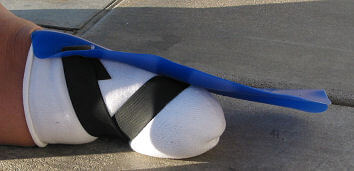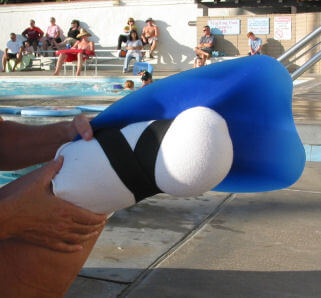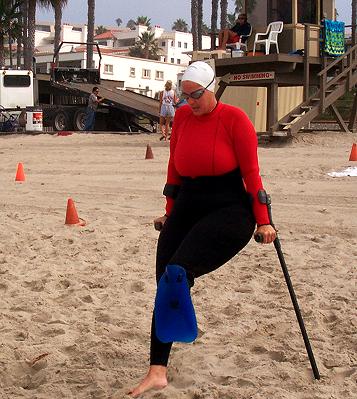Elle’, a below knee amputee, really benefits from shinfinTM fins for her rehabilitation, pool training and open water ocean swimming. They give her a smooth, level, relaxed and balanced stroke. What’s more, all without strain or calf cramps. She uses them for freestyle and backstroke, with and without a kickboard. The fin on her stump feels like a foot to her, because it gives a full workout of her amputated leg. Thus she fully strengthens her legs, stomach and back muscles. Not only for her swimming, but also for stronger walking with her prosthesis. Elle’ kindly shares her detailed story below, with photos and videos, so other amputees will benefit from shinfinTM fins too.
Elle’s review from San Clemente, USA
“Both legs are kicking evenly and my amputated leg is getting the full benefits of the workout. No more calf cramps. I found it felt like I have a foot. I am very aware of both legs working fully, rather than relying more on the remaining foot. I’m able to relax into my stroke, which is balanced, even and smooth. Enables me to completely engage my residual limb without stress or strain. And in turn build strength needed for wearing a prosthesis.”
“The open water swimming in the past days has been wonderful! I did not have rehabilitation after my amputation and swimming with the shinfinTM fins has been the best thing I could have ever found! I can feel my stomach and back work equally now. And I find my body position is much easier to keep level in the water.”
Elle’s review: Rehabilitation training fins for below knee amputee
“I’m a below knee amputee, training for ocean swim of triathlon.”
Elle’ (after first hour in pool)
“I am a below knee amputee, recently returned to swimming after my surgery. So I ordered your fins hoping they would work with my residual limb and reduce strain on my remaining foot.”
“I can’t tell you how very pleased and satisfied I am with them after my first hour in the pool today. The workout went so much faster and I was able to swim without using arm paddles to make up for the loss of my foot. Great work! I know they will be of great use in my training for open water swimming! We’ll be sending video when we get a chance.”
Reply
Many thanks for your kind email Elle’. As you will have found, the fins can be positioned at different heights on the lower legs or thighs. Therefore you can experiment to find the best position. So I’d be very interested to hear what you feel is the best position for you on your residual limb. Did you have the straps below or above your knee? You might find a better left right balance by moving the other fin a little higher up your shin. What do you think?
You probably felt the fins help to lift your legs horizontal to reduce drag and also give you extra kick power for swimming. Balancing the down kick of one leg with the upkick of the other, balances your whole stroke (arms too). They help you to get more power from your arm stroke because the left fin balances the forces from the right arm pull, and vice versa.
Yes, I would be very interested to see some photos and videos thank you.
Elle’
“For me the best position thus far, that has given me the most use of the limb, is strapped directly to the residual stump. I have to wear a sock as the material is painful pushing against the end bone. I’ve tried moving the fin up but don’t like the resultant kick. I am going to pad the area where I need it over the end bone.”

“I plan on doing photos and video for you, and I don’t have a problem with them being used for your product ads.”
“I’m getting the use of the leg back, in the sense that it’s more engaged naturally in the swimming. Rather than my remaining leg taking up the slack of the missing foot. I can use a kickboard now! I have the ability to do multiple laps with the kickboard, which to me shows how much the fins are going to open up my abilities and increase the strength in my residual limb.”
Reply
Many thanks for your kind reply Elle’. It sounds like you are getting on great. What kind of pad works best for you? Perhaps neoprene would be good. Can I ask please, how much residual stump do you have below the bottom of your kneecap?
Did you try backstroke with and without the kickboard? That may be good for your strengthening too.
Thanks again for offering the photos and video, that’s great. I really look forward to seeing them and hearing more about how you go.
Elle’ (after four swims)
“No thanks needed, your hard efforts and idea came to a beautiful fruition for yourself and others like me. Thus far I’ve used a stump sock folded up to run along the bone which took care of the problem yesterday. I’m chopped 8 inches below patella.”

“Yes, I also use the fins for backstroke, with and without a kickboard. Yesterday I did the kickboard front and back with the fin on my amputated side, towards the end of the workout. Great!”
“Before I got your fins, I had to use hand paddles in order to make up for the missing foot. My shoulders got one heck of a workout but my amputated leg was not working the same. At times it dragged behind me motionless, as my right foot was doing double duty to try to make up the loss.”
“Now, after four uses, both legs are kicking evenly and my amputated leg is getting the full benefits of the workout. I can swim without the paddles and with just one fin on, and still be able to do the kickboard. No more calf cramps. Now my lungs have to catch up with the abilities your fins have afforded me in speed.”
“Challenged Athletes Foundation is sponsoring a swim clinic. So can’t wait to share the fins with the group. I’ll be sure to get images of front and back strokes, with and without a kickboard.”
Reply
Thank you (again!) for your kind words and for the video. And for mentioning the fins to the Challenged Athletes Foundation, that is really good of you. How do you find your stroke balance when you have one fin on, compared to two fins?
Elle’
“I found it felt like I have a foot. I am very aware of both legs working fully, rather than relying more on the remaining foot. My tracking is straight in the lane, whereas I would drift during backstroke without the fin. I’m able to relax into my stroke, which is balanced, even and smooth.”
“I first swam laps with both fins on and after half an hour removed one, leaving the one on the stump. I noticed right away the improvement in my kick, which translated to my arm stroke. A benefit of being able to use the shinfinTM fin on the amputated side, is that it enables me to completely engage my residual limb without stress or strain. And in turn build strength needed for wearing a prosthesis.”
Reply
It’s clearly going best wearing one fin at the moment. As you regain strength on your amputated side, you may find that you want to wear the other fin too, to keep your stroke balanced. If you wear that fin a little higher up your shin then that might help your stroke balance. I think it would be worth experimenting with this when you feel ready.
Elle’
“I went to a Challenged Athletes Foundation sponsored clinic to get back in the water and get over being in public with my stump uncovered. I swam one mile twice a week at one time but not since the amputation. This was my first time back in the water. A swim technique teacher was checking my stroke and ability to see if I needed help.”
“The pool was open today so we were able to get some footage for you.”
Reply
Many thanks for all these videos and photos. The fin seems to be fitted nice and secure and your swimming looks really smooth, with balanced arms and legs. I can now see your stronger right arm pull when your left leg kicks down with the fin (improved from your “no-fin” video you sent first). So the diagonal cross-body balance is working nicely. It looks to me that you are already getting as much thrust with your left leg as your right leg. So, in a week or so you may even want to try adding the right fin, as I mentioned before.
Effect of kickboard flotation
I noticed that the extra flotation of the kickboard is tending to lift your upper body, and hence angle your legs down in the water. This is common. You can use the fin(s) for kick only exercises with a kickboard. But your body position and hence kicking technique is more likely to change, whatever position you hold the kickboard.
I think they work best for full stroke swimming, that’s what I really designed them for. So, for some kicking exercises, you might like to try keeping your arms going but with longer strokes and not pulling so hard. Then your kick technique is most likely to remain the same, so you are strengthening for the right action. Also, you should feel your arm stroke lengthening and becoming smoother, which is another benefit.
I hope this helps. Please let me know how you go and I’ll keep making suggestions to try to help you. I’d really like to use this as a case study on the website (subject to your permission of course). I like the way you write things and I think other amputees will really benefit from your comments.
Elle’
“You’re very welcome for the use of the videos and photos. If it will help someone else, please feel free to utilize them accordingly.”
“If you notice in the very first video I sent, I was breathing on my right, which I’ve done since I began swimming as a small child. I had to change that because I was straining my shoulder on the pull to breathe. I now breathe on my left and it’s working for me. This is something I’ve spoken to a triathlon athlete amputee about and he experiences the same issue.”
“I understand what you are saying about the use of the kickboard and noticed the change immediately. I’ll take your suggestion and do passive arm use while doing kicks, rather than employing the kickboard. Better body positioning and less strain on the back really.”
“I very much appreciate your assistance. I’ve done all my own rehabilitation at home. I’m large in body size but I’m very strong and extremely flexible. Anyway, I learned to walk, ride a bike and am now in training for an open water swim, my first since the amputation. Who knows what is next, it’s up to me to dream.”
Reply
Thank you for your permission. I wish you all the best with your training and look forward to hearing how you go if you get a moment to drop me an email. When is your open water swim?
Elle’ (after one week)
“You are welcome for the clearance to use the footage. Thank you for the tips and information that I’m on the right track. Open water swimming soon! Plan is to swim around the San Clemente Pier, 1/4 mile. From there I plan to build up to swim to Seal Rock which would put me at 1.5 miles one way. I’ve got one year to train for the swim portion of the San Diego Triathlon. 1.3 miles open water swim at La Jolla Cove in San Diego.”
“I’ve been doing as you suggested, swimming with only the fin on the stump and not using a kickboard but doing passive arm use. What a difference, with reduced back strain but improved propulsion.”
“Since using your fins for one week, I’ve now found that I have switched back to my breath stroke on the right! I’m not sure how this will work during a competition, as they don’t allow assistance devices like fins. So I will have to work on it.”
Reply
Thank you for this continued feedback Elle’. Yes, even the relatively small body angle caused by a kickboard makes a huge difference to body drag and swim technique (and back strain). I think you are going to continue to get very significant technique, strength and rehabilitation benefits from your swimming, to help you on your way to meet all your targets (and more).
Elle’ (after three weeks)
“I’m just going for my first open water swim since the amputation. I’m meeting with a few others at San Clemente Pier.”
“Most certainly I was wearing my shinfinTM fin. Don’t get in the water without it! It was great Marc. No problems and can’t wait to start catching some curl again!”
Reply
I’d be particularly interested to hear how swimming with the fin is helping to strengthen the muscles in your right thigh, back, stomach and torso areas. Is it also helping to balance your flexibility and strength on your left and right sides?
Elle’ (after five weeks)
“The open water swimming in the past four out of five days has been wonderful! I swim with just the one fin to make up for the missing foot as seen in the photo. My lower back hurts much less and my hips remain closer to even between chiropractic treatments, as noticed by my doctor. I’m not as tired when I complete a swim with the the fin as without the fin. And a lot less struggle, as my stroke has improved.”

“I took a short clinic that was offered by the Challenged Athletes Foundation coaches. My overall walking gait has gotten smoother and my hip strengthened due to use of the shinfinTM fins.”
“When walking, it’s not uncommon for an amputee to have what I call a ‘Giddyup in their Hitch’. The hip hikes up on the side that is missing. That in turn has an affect on the spine which causes the hip to elevate and put added strain on the lower back. I’ve gained the benefit of strengthening those muscles, without the strain or muscle ache I often felt after other types of exercises. It’s increased my confidence overall, now having the improved mobility afforded me by building the strength of my core muscle group.”
“I did not have rehabilitation after my amputation, and swimming with the shinfinTM fins has been the best thing I could have ever found! I can feel my stomach and back work equally now. And I find my body position is much easier to keep level in the water. As for flexibility, I can bend and move in ways most folks can’t. Wait till I use both shinfinTM fins!”
Reply
Many thanks for this Elle’, that is fantastic news and a really good description. I am particularly interested in what you say about hip mobility. What did the Challenged Athletes Foundation coaches think of your new fin? I’d like to add your experiences to create a dedicated page on my website, if that is still alright with you. I would like to base it on your words, as you describe it best.
Elle’
“Both coaches were amazed at how it went on and how well I moved with it in the water. I’ve got a lot of people interested, including my prosthetist in San Diego. He wants to use them for himself, as well as for in-service training for other amputees.”
“You are more than welcome to edit and use what you feel will be of service to you and your product from my writings. In doing so, details will become clearer and will be better able to answer other people’s questions.”
Reply
Thanks again for all your feedback and for helping to spread the shinfinTM word. Personal recommendation is very important to get a new product like this going, so I really appreciate it.
Conclusion
Below knee amputees really benefit from shinfinTM fins for rehabilitation, pool training, open water ocean swimming and many other water activities. They give you a horizontal, smooth, relaxed and balanced stroke. Furthermore, all in comfort without strain. And, as shown in this other review, swim training without calf cramps and Achilles pain too.
You can use them for freestyle, backstroke and butterfly, with or without a kickboard. The fin on your stump might even feel like a foot to you, because it helps to fully workout your amputated leg. Thus you fully strengthen your legs, stomach and back muscles. Not only to benefit your swimming, but also for stronger walking with your prosthesis.
This other review shows a below knee amputee helped by shinfinTM fins for freestyle and butterfly rehabilitation training. As shown by these further reviews, they can also be used for rehabilitation recovery after things like back surgery and back fusion and knee reconstruction.